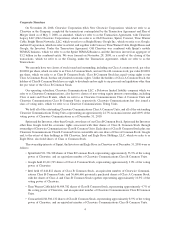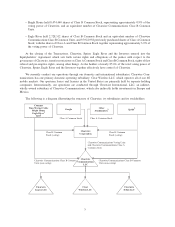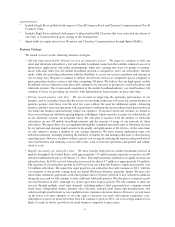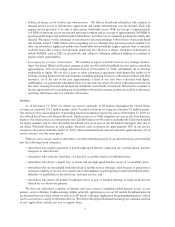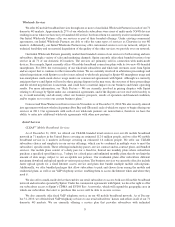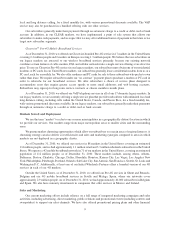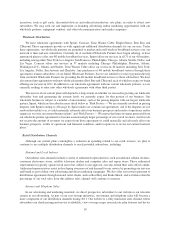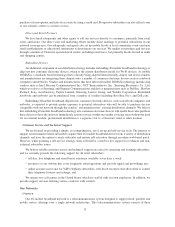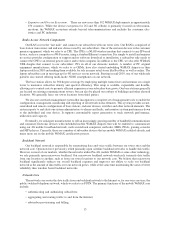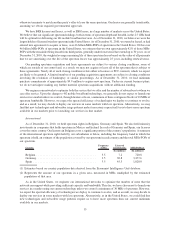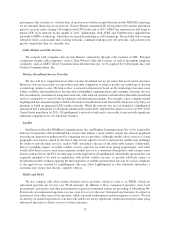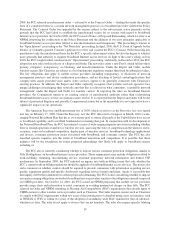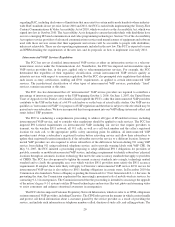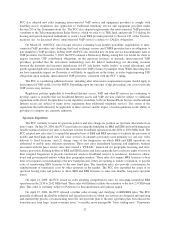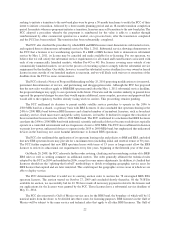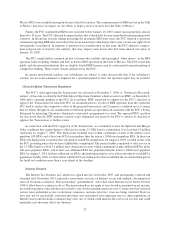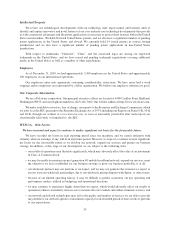Clearwire 2010 Annual Report Download - page 19
Download and view the complete annual report
Please find page 19 of the 2010 Clearwire annual report below. You can navigate through the pages in the report by either clicking on the pages listed below, or by using the keyword search tool below to find specific information within the annual report.• controlling IP addresses and connecting to the Internet; and
• offering value-added services such as live video, location-based services, and music broadcast
programming.
Network Management and Operational Support Systems
We also use a network management system that incorporates a complete set of management tools to enable the
configuration, management, monitoring and reporting of all network status elements. This system provides secure,
centralized and remote configuration of base stations, CPE, switches and other network elements. The system
reports to and alerts our system administrators to alarms and faults, and monitors system performance down to the
individual CPE. It supports customizable report generation to track network performance, utilization and capacity.
Spectrum
Our network operates over licensed spectrum in our domestic and international markets. Although several
broadband technologies can operate in unlicensed or public access spectrum, we believe using licensed spectrum
enables us to provide a consistently higher quality of service to our subscribers, without the interference that is
typically associated with unlicensed frequency bands.
United States
We hold approximately 140 MHz of spectrum on average across our national spectrum footprint and
approximately 160 MHz of spectrum on average in the 100 largest markets in the United States. Our deep
spectrum position in most of our markets is expected to enable us to offer our subscribers significant mobile data
bandwidth, with potentially higher capacity than is currently available from other carriers.
In the United States, licensed spectrum is governed by the Federal Communications Commission, which we refer
to as FCC, rules that provide a license holder with exclusive use of a specified spectrum frequency band and restrict
interference from other licensees and spectrum users, providing some protection against interruption and degradation
of service. Under FCC rules, unlicensed spectrum users do not have exclusive use of any frequencies, may not cause
interference with the operations of any licensed operators and may suffer interference from others using licensed
frequencies in overlapping geographic areas, making quality and availability of their services unpredictable.
We have designed our network in the United States to operate primarily on spectrum located within the 2496 to
2690 MHz band, commonly referred to as the 2.5 GHz band, which is designated for Broadband Radio Service,
which we refer to as BRS, and Educational Broadband Service, which we refer to as EBS. Most BRS and EBS
licenses are allocated to specific Geographic Service Areas. Other BRS licenses provide for 493 separate Basic
Trading Areas, which we refer to as BTAs. Under current FCC rules, the BRS and EBS band in each territory is
generally divided into 33 channels consisting of a total of 186 MHz of spectrum, with an additional eight MHz of
guard band spectrum, which further protects against interference from other license holders. Under current FCC
rules, we can access BRS spectrum either through outright ownership of a BRS license issued by the FCC or through
a leasing arrangement with a BRS license holder. The FCC rules generally limit eligibility to hold EBS licenses to
accredited educational institutions and certain governmental, religious and nonprofit entities, but permit those
license holders to lease up to 95% of their capacity for non-educational purposes. Therefore, apart from a few EBS
licenses we acquired under an old EBS rule, we access EBS spectrum through long-term leasing arrangements with
EBS license holders. EBS leases entered into before January 10, 2005 may remain in effect for up to 15 years and
may be renewed and assigned in accordance with the terms of those leases and the applicable FCC rules and
regulations. The initial term of EBS leases entered into after January 10, 2005 is required by FCC rules to be
coterminous with the term of the license. In addition, these leases typically give the leaseholder the right to
participate in and monitor compliance by the license holder with FCC rules and regulations. EBS leases entered into
after July 19, 2006 that exceed 15 years in length must give the licensee the right to reassess their educational use
requirements every five years starting in year 15. Our EBS spectrum leases typically have an initial term equal to the
remaining term of the EBS license, with an option to renew the lease for additional terms, for a total lease term of up
to 30 years. In addition, we generally have a right of first refusal for a period of time after our leases expire or
14


